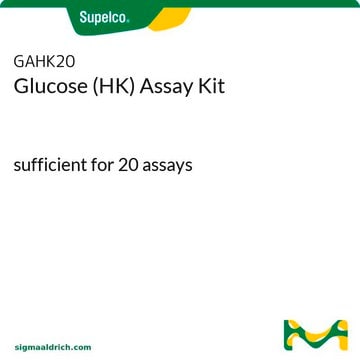MAK076
Ethanol Assay Kit
sufficient for 100 colorimetric or fluorometric tests
Iniciar sesiónpara Ver la Fijación de precios por contrato y de la organización
About This Item
UNSPSC Code:
12161503
NACRES:
NA.84
Productos recomendados
usage
sufficient for 100 colorimetric or fluorometric tests
application(s)
cosmetics
food and beverages
detection method
colorimetric
fluorometric
storage temp.
−20°C
General description
The new Ethanol Assay Kit, MAK481, is now available! Ethanol is a psychoactive component of many commonly consumed drinks where it acts as a central nervous system depressant. After ingestion, ethanol is absorbed into the bloodstream via the stomach and small intestine. Ethanol is largely metabolized by the liver but is also secreted in urine or through respiration. The monitoring of ethanol levels is also important in fermentation processes. The ethanol assay kit provides a simple and reliable method for the quantification of ethanol.
This kit is highly sensitive to the presence of short-chain alcohols (ethanol, methanol, and propanol). Storage or use of this kit in the vicinity of alcohol vapors can result in the uptake of the alcohols by kit components, resulting in very high backgrounds.
This kit is highly sensitive to the presence of short-chain alcohols (ethanol, methanol, and propanol). Storage or use of this kit in the vicinity of alcohol vapors can result in the uptake of the alcohols by kit components, resulting in very high backgrounds.
Application
Ethanol Assay Kit has been used :
- to measure the levels of ethanol in yeast cell culture supernatant and to study the link between metabolism and chromatin structure
- to determine the ethanol levels in compound beverages and foods
- to measure ethanol content in vinegar
Suitability
Suitable for determining the concentration of ethanol in serum, plasma, and other body fluids as well as in beverages and growth media.
Principle
Ethanol concentration is determined by a coupled enzyme reaction, which results in a colorimetric (570 nm)/fluorometric (λex = 535/λex = 587 nm) product, proportional to the ethanol present. The Ethanol Assay Kit provides a simple and reliable method for the quantification of ethanol in serum, plasma, and other body fluids as well as in beverages and growth media.
replaced by
Referencia del producto
Descripción
Precios
signalword
Danger
hcodes
Hazard Classifications
Aquatic Chronic 3 - Eye Irrit. 2 - Flam. Liq. 2
Storage Class
3 - Flammable liquids
flash_point_f
57.2 °F - closed cup
flash_point_c
14.0 °C - closed cup
Certificados de análisis (COA)
Busque Certificados de análisis (COA) introduciendo el número de lote del producto. Los números de lote se encuentran en la etiqueta del producto después de las palabras «Lot» o «Batch»
¿Ya tiene este producto?
Encuentre la documentación para los productos que ha comprado recientemente en la Biblioteca de documentos.
Los clientes también vieron
Metabolite profiling and volatiles of pineapple wine and vinegar obtained from pineapple waste.
Roda A, et al.
Food Chemistry, 229, 734-742 (2017)
Detecting ethanol and acetaldehyde by simple and ultrasensitive fluorimetric methods in compound foods.
Zachut M, et al.
Food Chemistry, 201, 270-274 (2016)
Michael S Patton et al.
Neuropsychopharmacology : official publication of the American College of Neuropsychopharmacology, 46(2), 351-359 (2020-07-15)
Compulsive alcohol consumption is a core, treatment-resistant feature of alcohol use disorder. The dorsomedial and dorsolateral striatum support goal-directed and habitual action strategies, respectively. How ethanol targets dorsolateral striatum to drive compulsive consumption is poorly understood. Parvalbumin-expressing striatal fast-spiking interneurons
Shiyu Xu et al.
eNeuro, 5(3) (2018-06-19)
Ethanol has robust effects on presynaptic activity in many neurons, however, it is not yet clear how this drug acts within this compartment to change neural activity, nor the significance of this change on behavior and physiology in vivo. One
Gemma Aragonès et al.
International journal of obesity (2005), 44(4), 875-885 (2019-08-08)
Non-alcoholic fatty liver disease (NAFLD) causes a wide spectrum of liver damage, from simple steatosis (SS) to cirrhosis. SS and non-alcoholic steatohepatitis (NASH) cannot be distinguished by clinical or laboratory features. Dysregulation of the gut microbiota is involved in NASH
Nuestro equipo de científicos tiene experiencia en todas las áreas de investigación: Ciencias de la vida, Ciencia de los materiales, Síntesis química, Cromatografía, Analítica y muchas otras.
Póngase en contacto con el Servicio técnico








